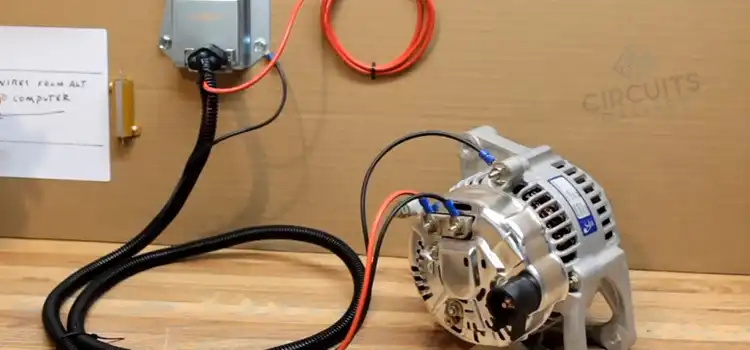How to Bypass Voltage Regulator? – Things You’ll Need to Do
You can bypass a voltage regulator with the help of an alternate regulator and connect it to the battery. You will also need the plug harness and the wires to connect the regulator to the battery.
An alternator turns mechanical energy into electrical energy, and a regulator keeps the current in the car stable. If something goes wrong with your voltage regulator, you may experience issues with battery charge levels.

Step-by-Step for Bypassing Voltage Regulator
If the voltage regulator is just regulating the output of one line to another, it only requires connections to those two wires (plus the power in, which must be referred to as the regulator’s common). That is frequently the case with power supply output, which can be floating and not linked to the ground.
Perform the following steps to bypass a voltage regulator:
Step #1: Turn the engine off and disconnect the voltage regulator connector.
Step #2: Connect a jumper wire between the plug’s “A” and “F” terminals, as shown on the right. After bypassing the regulator, repeat the load test.
Step #3: If the full-field voltage is more than 1/2 volt higher than the engine-off voltage, the regulator is faulty and must be replaced.
Step #4: If the voltage rise is less than 1/2 volt, the alternator or wiring is faulty.
Step #5: Examine the wiring for wear or heat damage. If the wiring appears to be in good condition, the faulty component is most likely the alternator.
Step #6: When doing the no-load, load, and full-field tests on a vehicle equipped with a catalytic converter, strive to complete them in less than 5 minutes of total engine running time.
Step #7: If more time is required to complete the tests, wait 30 minutes before proceeding. This will allow the catalytic converter to cool and protect it from harm.
Can a Car Run Without a Voltage Regulator?
Without a voltage regulator, an alternator can produce up to 250 volts. This is enough to ruin the car’s battery and electrical system. The voltage regulator is normally located within or on the rear of the alternator housing. You might be able to drive with a defective voltage regulator for a while, but not for long.
Driving with a malfunctioning voltage regulator is technically possible, but it is dangerous. You might be right and nothing happens, but you risk exploding some expensive electrical components if the voltage is not steady. If your voltage regulator fails, you should replace it as quickly as possible.
What Is a Car Voltage Regulator?
Your car voltage regulator (also known as a switching regulator) regulates the voltage produced by the alternator (generator in older cars or starter generator in tractors). The input voltage would be too high without the alternator voltage regulator. So, the electrical systems in your vehicle will be overloaded.
To avoid this, the voltage regulator works similarly to a linear regulator in that it guarantees the alternator output maintains a constant charging voltage of 13.5V to 14.5V. That’s enough steady voltage to recharge your car’s battery without overloading its electrical components and circuits.
How Does a Car Voltage Regulator Work?
Understanding the inner workings of a car voltage regulator can shed light on its importance. Here’s a simplified breakdown of the process:
Today’s electronic voltage regulators are robust but challenging to repair. When they malfunction, it’s often more practical to replace them rather than attempting repairs. Some vehicles also feature an engine control module (ECM) that manages alternator voltage levels through a dedicated circuit, offering enhanced fault detection capabilities.
Can You Run an Alternator Without a Voltage Regulator?
The alternator voltage regulator is essential to maintain safe voltage levels in your vehicle’s electrical system. Without it, your alternator’s output voltage can spike dangerously high, posing a severe risk to your car’s electrical components and circuits. To avoid this, the voltage regulator ensures that your alternator provides a consistent charging voltage between 13.5V and 14.5V.
How Do You Fix a Voltage Regulator?
Perform the following steps to fix a malfunctioned voltage regulator:
- Evaluate Electrical Performance: Erratic engine performance is typically caused by a malfunctioning regulator that is unable to control the output voltage level generated by the alternator. If you discover that your engine performance is unusual or unpredictable, evaluate your vehicle’s electrical systems.
- Check the Battery: If you have a bad or dead battery, call a professional right away. Allow them to determine whether the problem is with your voltage regulator or another electrical component. In addition, the mechanic will inform you if you require a new battery.
What is the lifespan of a voltage regulator?
It can be difficult to anticipate the exact lifespan of your alternator voltage regulator. However, under normal environmental conditions, your voltage regulator may outlive the useful life of your car. To be more specific, many mechanics agree that the voltage regulator in your vehicle can survive up to 100,000 kilometers.
Conclusion
In conclusion, your car’s voltage regulator is a vital component that ensures your electrical system functions smoothly. When it misbehaves, it can lead to erratic performance and potential damage. While it’s possible to drive without a functioning regulator for a short time, it’s not advisable due to the risks involved. Timely replacement of a faulty voltage regulator is essential for maintaining the health and efficiency of your vehicle’s electrical systems.
Subscribe to our newsletter
& plug into
the world of circuits